This post may contain affiliate links. Please read our disclosure policy.
Make creamy Hollandaise sauce in minutes using a blender, a few ingredients, and my easy, no-fail method. Perfect for breakfast, brunch, eggs Benedict, and more!

I love a silky, velvety, and wonderfully rich sauce to enjoy with my weekly eggs Benedict, over asparagus, or with seafood. So this quick Hollandaise sauce is my go-to recipe—it requires just five ingredients (plus salt and pepper), a blender, and just a few minutes to make. My tried-and-tested method is fool-proof, so you can always impress your family and guests at breakfast, brunch, and dinner.
Table of Contents

What is Hollandaise sauce?
Hollandaise sauce (formerly Dutch sauce) is a classic French emulsion-based sauce similar to homemade mayonnaise. Its ingredients include egg yolks, melted butter, lemon juice, and vinegar. This quick blender version is also simple to prepare.
The sauce is rich, smooth, and creamy and is usually served warm as a topping for eggs Benedict, steamed vegetables, fish, and more.
Ingredients

- Egg yolks: This sauce’s incredible richness comes from egg yolks. I recommend using pasteurized eggs (or you can pasteurize eggs yourself as they won’t be heated in this recipe. Use room-temperature eggs.
- Butter: Use high-quality unsalted butter for the best flavor and consistency.
- Vinegar: I use white wine vinegar, which I reduce for the best flavor and consistency. However, feel free to omit this and use additional lemon juice, if preferred (half the amount).
- Lemon: Use fresh lemon juice (not bottled) for the best flavor, though either will work.
- Spices: Use sea salt, black pepper, and a pinch of cayenne pepper (optional).
You can save the leftover egg whites to make meringue or pavlova recipe, an egg-white omelet or scramble, or replace whole eggs with egg whites in baking recipes.
How to make Hollandaise sauce
Prepare the ingredients: First, separate egg whites and yolks and juice the lemon. Then, transfer the white wine vinegar to a small saucepan and heat it over medium-low heat until it reduces by half.
At the same time, melt the butter in a separate small pan until it begins to bubble. Then, scoop off and remove any white foam. You can also pour it through a fine-mesh sieve or a coffee filter to remove any impurities. Finally, move to the next step quickly after heating the butter. If you allow it to cool, you risk the emulsification not working properly. The melted butter needs to be HOT.
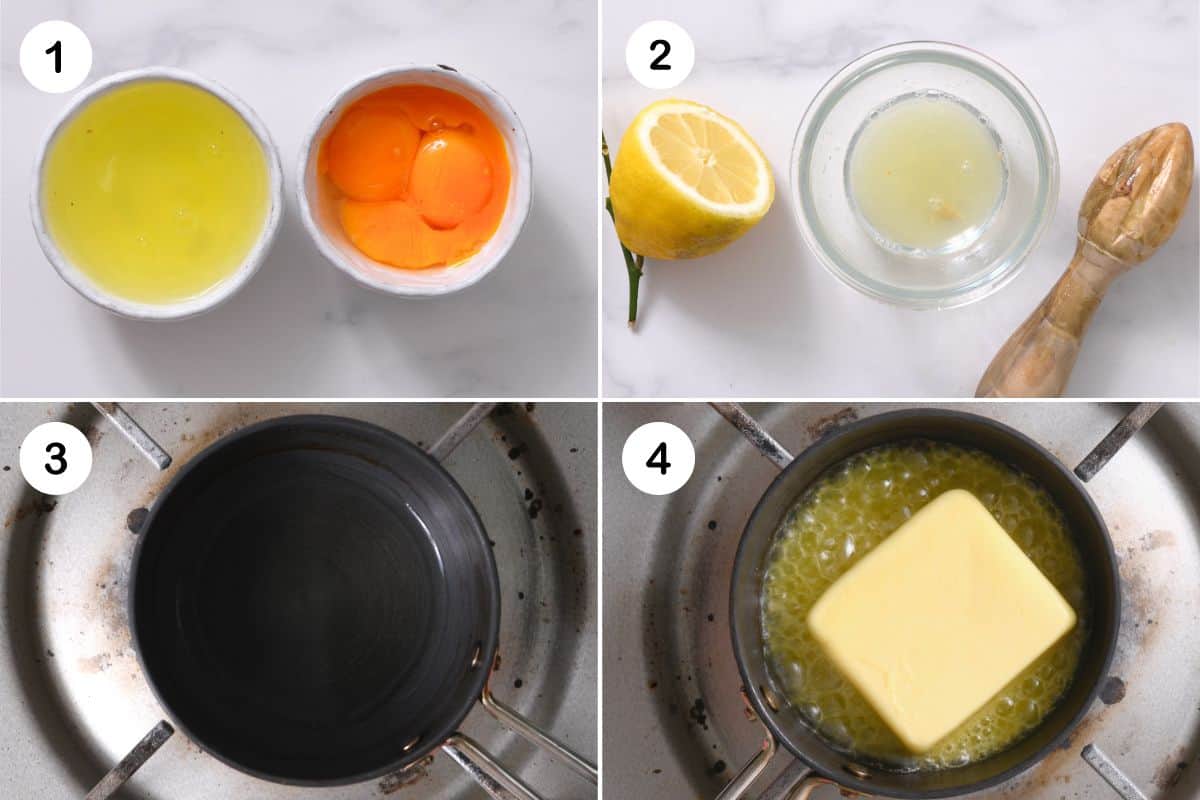
Blend the Hollandaise sauce: Use a food processor/blender with a pouring spout or an immersion blender. Place the egg yolks, lemon juice, reduced vinegar, and cayenne pepper in your food processor or a tall immersion blender cup (or jar). If you’re using an immersion blender, ensure it touches the bottom of the container.
Run the blender on high to combine the ingredients. Then lower the speed to medium, and very slowly pour in the melted butter while blending. A thick, creamy-looking, smooth sauce will start to emulsify near the blades. If using an immersion blender, slowly pull the blender up toward the top of the mixture as it emulsifies. That way, you can ensure it is fully emulsified and is rich and creamy.

Taste and enjoy: Finally, the homemade hollandaise sauce can now be seasoned with salt and black pepper to taste. Then serve warm and enjoy!
Ways to use Hollandaise sauce
There are plenty of ways to enjoy this creamy sauce:
- Top Eggs Benedict – these are a classic brunch choice made with English muffins, bacon or smoked salmon, and poached eggs, all topped with the sauce.
- Serve with other brunch favorites.
- Pour over air fryer asparagus, artichokes, roasted cauliflower and broccoli, and other grilled, roasted, or steamed vegetables.
- Spoon over poached eggs(find top tips to poach an egg properly), sweet potato rosti, or hash browns.
- Serve with baked or smoked salmon or other seafood like crab, scallops, or white fish.
- Serve over steak or chicken.
- Enjoy with savory “eggy bread” (French toast).
It also makes for a great holiday sauce, perfect for impressing at a Thanksgiving or Christmas brunch or for a quick holiday snack.

How to store and reheat
Store: I prefer to enjoy this blender hollandaise sauce fresh for the best flavor and consistency. However, if needed, you can store any leftovers in an airtight container in the refrigerator for 1-2 days.
Reheat: Be careful when reheating Hollandaise so the egg yolks don’t cook. Reheat in a small saucepan on the stovetop over low heat. Add a little more melted butter if necessary to re-emulsify. You can also microwave in 15-second increments until warmed through.
More homemade sauces
If you try this Hollandaise sauce recipe, let me know how it goes in the comments below. I’d appreciate a recipe card rating and would love to see your recipe recreations – tag me on Instagram @Alphafoodie!
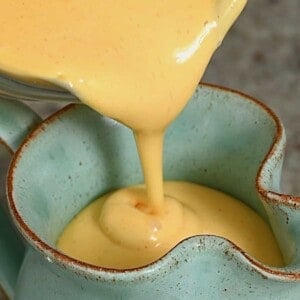
Quick Hollandaise Sauce (No-Fail)
Equipment
- Hand-held blender or a food processor/blender with a pouring spout
Ingredients
- 3 egg yolks pasteurized is best, at room temperature
- 4 oz butter unsalted; 1 stick
- 3 Tbsp white wine vinegar
- 3 Tbsp lemon juice from 1 lemon
- 1/4 tsp salt
- 1/8 tsp black pepper
- 1/4 tsp cayenne pepper optional, adjust to taste
Instructions
Prepare the ingredients
- Separate the egg yolks from the whites. If needed, check my top tips here. Juice the lemon.
- Heat the white wine vinegar in a small saucepan over medium-low until it reduces by half.
- Melt the butter in a separate small pan until it begins to bubble. Scoop off and remove any white foam, or pour through a fine-mesh sieve or coffee filter to remove impurities. Quickly proceed with the next step while the butter is hot.
Blend the Sauce
- Use a food processor/blender with a pouring spout or an immersion blender.
- Place the egg yolks, lemon juice, reduced vinegar, and cayenne pepper in the jug or a tall cup/jar. If you're using an immersion blender, ensure it touches the bottom of the container.Run the blender on high to combine the ingredients.
- Lower the speed to medium and very slowly pour in the melted butter while blending. A thick and creamy sauce will start to emulsify. If using an immersion blender, slowly pull it up toward the top of the mixture as it emulsifies.
- Season the homemade Hollandaise sauce with salt and black pepper to taste, and serve warm
Notes
Nutrition
Nutrition information is automatically calculated, so should only be used as an approximation.

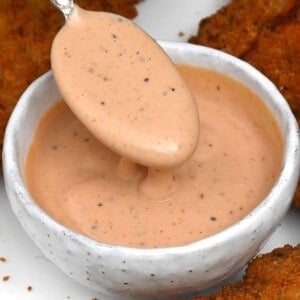
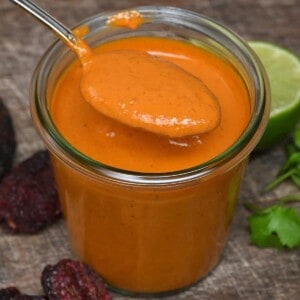
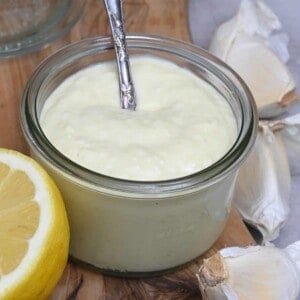
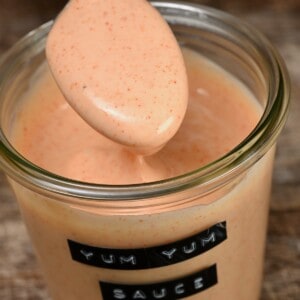









I find the microwave version is better and much less room for error. I also use terrain vinegar to make bearnaise. So yummy.
Thank you for your feedback, Christine. 🙂